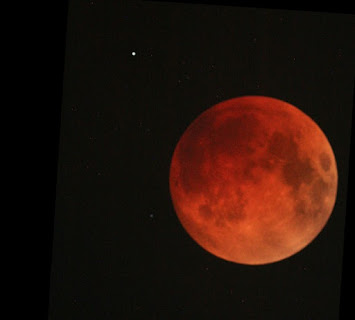Physics Photo of the Week
November 11, 2022
Total Lunar Eclipse from May, 2022 - Revisited (Photos by Donald Collins)
Notice in the picture of the totally eclipsed Moon, we can see two stars. Faint stars near the Moon are normally not visible in photographs of the normal un-eclipsed Moon, because the camera is overwhelmed by the Moon's extreme brightness compared with the stars. The faint total eclipse permits the faint stars to be seen very close to the Moon,
I made a series of total eclipse images from last May's eclipse. The first image (above) was taken soon after totality began; the last image was taken soon before totality ended - about 48 minutes after totality began. The stars and the Moon are seen in each of these images which are displayed in an animated sequence below.
If the telescope and camera were stationary, The stars would appear moving to the right due to the Earths diurnal (daily) rotation. From a stationary telescope the Moon would also show movement to the right due to Earth's rotation, but the Moon would not appear to move as fast as the stars due to the Moon's monthly rotation about the Earth. The telescope for this project has a clock drive to follow the stars' apparent motion in the sky. The clock drive allows long time exposures to capture still images of the stars. Notice that the stars appear stationary in the animated sequence, but the Moon moves further to the left (East) in each of the image relative to the stars. In the final frame the Moon has totally covered one of the two stars. During the 48 minutes of the total eclipse sequence, the Moon has moved about one lunar radius relative to the stars due to its orbital motion around the Earth.
There was a total lunar eclipse before dawn this past Tuesday am (November 8, 2022) which I totally missed due to a preponderance of many other projects. I welcome any photos or discussions of the appearance of the Moon from any readers who have seen the Nov. 8 eclipse.
======================================================================
Physics Photo of the Week is published weekly during the academic year on Fridays by the Warren Wilson College Physics Department. These photos feature interesting phenomena in the world around us. Students, faculty, and others are invited to submit digital (or film) photographs for publication and explanation. Atmospheric phenomena are especially welcome. Please send any photos to dcollins@warren-wilson.edu.
All photos and discussions are copyright by Donald Collins or by the person credited for the photo and/or discussion. These photos and discussions may be used for private individual use or educational use. Any commercial use without written permission of the photoprovider is forbidden.





Comments
Post a Comment